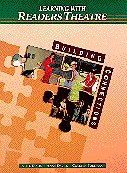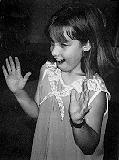


|
Learning with Readers Theatre.
Neill Dixon, Anne Davies, Colleen Politano. Subject Headings:
Grades 1 - 6 / Ages 6 - 11. **** /4
|

All: Readers Theatre...Readers Theatre...Readers Theatre...
Reader 1: Readers Theatre.
Reader 2: What is it?
Reader 1: It is reading.
Reader 3: Reading a script...
Reader 2: as a character...
Reader 1: as a storyteller.
Reader 3: It is theatre...
Reader 2: that isn't memorized...
Reader 1: and we can read more than one part...
Reader 2: by changing our voices.
 So begins the first sample script in Learning with Readers Theatre, a
highly recommended volume in the Building Connections series for teachers.
The authors are well qualified. Dixon has been teaching readers theatre
(RT) as a road to reading comprehension for many years and has been a
member of the faculty of the Institute for Readers Theatre in San Diego.
Davies and Politano are experienced classroom teachers and this book
evolved from their workshops on Readers Theatre. The Canadian connection
is also strong - many of the materials were developed and extensively used
in schools in Courtenay, British Columbia.
So begins the first sample script in Learning with Readers Theatre, a
highly recommended volume in the Building Connections series for teachers.
The authors are well qualified. Dixon has been teaching readers theatre
(RT) as a road to reading comprehension for many years and has been a
member of the faculty of the Institute for Readers Theatre in San Diego.
Davies and Politano are experienced classroom teachers and this book
evolved from their workshops on Readers Theatre. The Canadian connection
is also strong - many of the materials were developed and extensively used
in schools in Courtenay, British Columbia.
This book focuses on using RT with elementary school-aged students
and covers mainly language arts topics with a nod to reading across the
curriculum. Its presentation is more like a manual than a book, with
easy-to-read font, and black and white illustrations/diagrams which are
helpful visual representations of the ideas being discussed. Teachers can
pick and choose sections and will find reproducible scripts and complete
directions that will allow them to start using readers theatre with a
minimum of preparation. The book's organization facilitates this process
with a detailed table of contents (chapters on writing scripts, staging and
evaluating, for example); a brief but helpful glossary (eight terms); and a
bibliography for those who find their appetites whetted for further
information. Unfortunately, however, there is no index.
Learning with Readers Theatre is the best book on the topic I have
seen. It will replace many bits and pieces in my own collection with a
single book. If I were to criticize its treatment of oral language for
learning, I would have to point to the rather weak coverage of RT in the
content areas. I found the ideas here to be mainly adjuncts to rather than
being woven into the teaching of various subjects. One example is a script
made up by teachers to introduce continents, oceans and provinces in a
Social Studies class. The danger I saw in this script was that it could
encourage using RT as a performance activity rather than a learning one.
This, I hasten to add, is not the message in the rest of the book and it
was disappointing to see it here. By grades 5 and 6, students should
certainly be doing rather sophisticated work in science and time to do RT
must be carefully used to ensure that curriculum concepts are being met.
In conclusion, I highly recommend Learning with Readers Theatre for
teachers who have never tried this approach or for those who would like to
add an easy-to-use manual to their collection of RT scripts.
Reading/writing, listening/speaking, viewing/representing were never easier
to integrate than with the Readers Theatre approach!
Highly Recommended
Dr. Begoray is a faculty member of Education at The University of Winnipeg with teaching and research interests in English and Language Arts teacher education.

To comment on this title or this review, send mail to cm@umanitoba.ca.
Copyright © 1996 the Manitoba Library Association. Reproduction for personal use is permitted only if this copyright notice is maintained. Any other reproduction is prohibited without permission.
Published by
The Manitoba Library Association
ISSN 1201-9364
AUTHORS |
TITLES |
MEDIA REVIEWS |
BOOKSHELF
BACK ISSUES |
SEARCH |
HOME